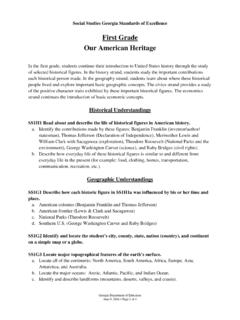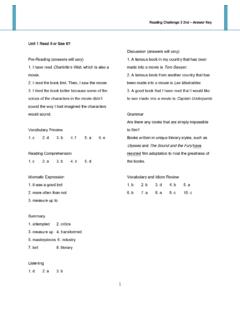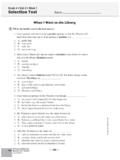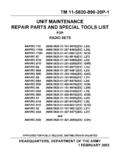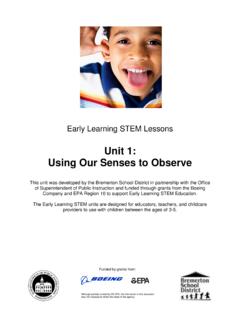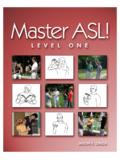Transcription of Georgia Standards of Excellence Curriculum …
1 Georgia Standards of Excellence Curriculum Frameworks Mathematics GSE First Grade unit 1: Creating Routines Using Data These materials are for nonprofit educational purposes only. Any other use may constitute copyright infringement. Georgia Department of education Georgia Standards of Excellence Framework GSE First Grade unit 1. unit 1: Creating Routines Using Data TABLE OF CONTENTS. Classroom video available here: Task-Classroom- Overview .. 3. Standards for Mathematical Practice .. 4. Standards for Mathematical Content .. 4. Big Ideas .. 5. Essential Questions .. 5. Concepts and Skills to Maintain .. 5. Strategies for Teaching and Learning .. 6. Selected Terms and Symbols .. 8. FALS .. 8. Number 9.
2 Writing in 9. Page Citations .. 10. Tasks .. 11. Intervention Table ..13. Making Sets of More/Less/Same10 .. 14. The 19. How many are here today? .. 27. Group it and Move it .. 31. Spin and Represent .. 37. Creating a Number 42. Hop To It .. 49. Exploring the 99 Chart .. 56. FAL .. 64. Graphing with Classmates .. 65. Trashcan Basketball .. 70. Bunch of Bananas .. 73. Oh No 99 Chart!..77. Favorite Sports .. 82. IF YOU HAVE NOT READ THE FIRST GRADE Curriculum OVERVIEW IN ITS. ENTIRETY PRIOR TO USE OF THIS unit , PLEASE STOP AND CLICK HERE: Return to the use of this unit once you've completed reading the Curriculum Overview. Thank you. Mathematics GSE First Grade unit 1: Creating Routines Using Data Richard Woods, State School Superintendent July 2018 Page 2 of 84.
3 All Rights Reserved Georgia Department of education Georgia Standards of Excellence Framework GSE First Grade unit 1. OVERVIEW. The Overview is designed to bring focus to the Standards so that educators may use them to build their Curriculum and to guide instruction. For more detailed information about unpacking the content Standards , unpacking a task, math routines and rituals, maintenance activities and more, please refer to the Grade Level Overview. In this unit , students will: Establish daily math routines to be carried out throughout the year, such as lunch count, daily questions, calendar activities, working with a 0-99 chart, etc. Rote count forward to 120 by Counting On from any number less than 120.
4 Represent the number of a quantity using numerals. Locate 0-120 on a number line. Use the strategies of counting on and counting back to understand number relationships. Explore with the 99 chart to see patterns between numbers, such as all of the numbers in a column on the hundreds chart have the same digit in the ones place, and all of the numbers in a row have the same digit in the tens place. Read, write and represent a number of objects with a written numeral (number form or standard form). Build an understanding of how the numbers in the counting sequence are related each number is one more or one less than the number before or after. Work with categorical data by organizing, representing and interpreting data using charts and tables.
5 Pose questions with 3 possible responses and work with the data that they collect. All mathematical tasks and activities should be meaningful and interesting to students. Posing relevant questions, collecting data related to those questions, and analyzing the data creates a real world connection to counting. The meaning students attach to counting is the key conceptual idea on which all other number concepts are developed. Students begin thinking of counting as a string of words, but then they make a gradual transition to using counting as a tool for describing their world. They must construct the idea of counting using manipulatives and have opportunities to see numbers visually (dot cards, tens frames, number lines, hundreds charts, arithmetic rack- ex: small frame abacus and physical groups of tens and ones).
6 To count successfully, students must remember the rote counting sequence, assign one counting number to each object counted, and at the same time have a strategy for keeping track of what has already been counted and what still needs to be counted. Only the counting sequence is a rote procedure. Most students can count forward in sequence. Counting on and counting back are difficult skills for many students. Students will develop successful and meaningful counting strategies as they practice counting and as they listen to and watch others count. They should begin using strategies of skip counting by 2's, 5's, and 10's. As students in first grade begin to count larger amounts, they should group concrete materials into tens and ones to keep track of what they have counted.
7 This is an introduction to the concept of place value. Students must learn that digits have different values depending on their position in numbers. Mathematics GSE First Grade unit 1: Creating Routines Using Data Richard Woods, State School Superintendent July 2018 Page 3 of 84. All Rights Reserved Georgia Department of education Georgia Standards of Excellence Framework GSE First Grade unit 1. Although the units in this instructional framework emphasize key Standards and big ideas at specific times of the year, routine topics such as counting, time, money, positional words, patterns, and tallying should be addressed on an ongoing basis through the use of calendars, centers, and games. This first unit should establish these routines, allowing students to gradually understand the concept of number and time.
8 Picture graphs and bar graphs are not introduced until 2nd grade. Students in first grade are asked to construct tables and charts. Teachers may introduce vocabulary words to students in first grade as a pre-teaching opportunity. Standards FOR MATHEMATICAL PRACTICE. The Standards for Mathematical Practice describe varieties of expertise that mathematics educators at all levels should seek to develop in their students. These practices rest on important processes and proficiencies with longstanding importance in mathematics education . Students are expected to: 1. Make sense of problems and persevere in solving them. 2. Reason abstractly and quantitatively. 3. Construct viable arguments and critique the reasoning of others.
9 4. Model with mathematics. 5. Use appropriate tools strategically. 6. Attend to precision. 7. Look for and make use of structure. 8. Look for and express regularity in repeated reasoning. **Mathematical Practices 1 and 6 should be evident in EVERY lesson**. Standards FOR MATHEMATICAL CONTENT. Extend the counting sequence. Count to 120, starting at any number less than 120. In this range, read and write numerals and represent a number of objects with a written numeral. Represent and interpret data. Organize, represent, and interpret data with up to three categories; ask and answer questions about the total number of data points, how many in each category, and how many more or less are in one category than in another.
10 BIG IDEAS. Count on starting at any number less 100 and continue to 120. Read, write and represent a number of objects with a written numeral. Quantities can be compared using matching and words. Mathematics GSE First Grade unit 1: Creating Routines Using Data Richard Woods, State School Superintendent July 2018 Page 4 of 84. All Rights Reserved Georgia Department of education Georgia Standards of Excellence Framework GSE First Grade unit 1. Recognize and understand patterns on a 99 chart (tens and ones). A number line can represent the order of numbers. Problems can be solved in different ways. Important information can be found in representations of data such as tallies, tables, and charts. Tables and charts can help make solving problems easier.









